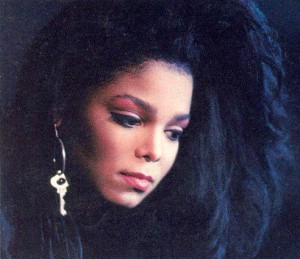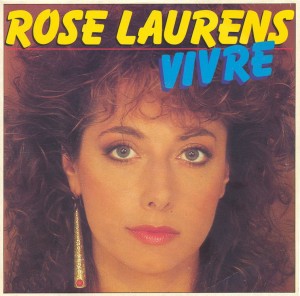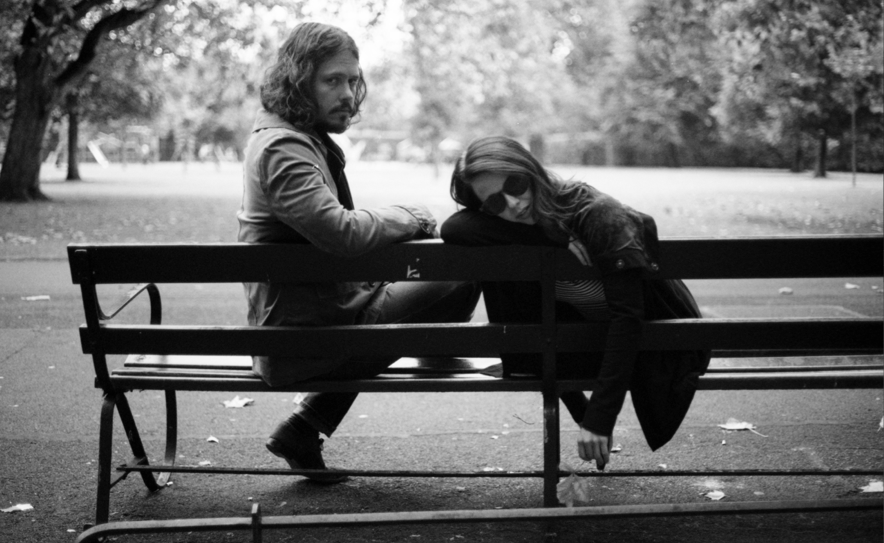
In order to prepare for this post, I’ve picked out the appropriate ear-wear. As I write, I’m wearing one dangly earring in my right ear and a less conspicuous one in my left. I feel a certain solidarity with my pop icons from the 1980s and ’90s and also like I’m part of a larger feminist effort to debunk symmetry rules for ear jewelry. It was a symbolic revolution at the time. Now, some 20 years later, I’m silently rekindling it in my little workspace.
Janet Jackson was one artist who did the one-earring statement very well. (I credit her as having started it, but she probably didn’t.) In an interview before one of her first television appearances as a serious artist, she wears a large hoop earring with a key looped into it. The show’s host asks her what the key is for, which is an obvious question for him because all he sees is a large object on the side of Janet’s face, and she’s clearly not hiding it by so ostensibly displaying it within the viewfinder of the camera. The response comes from a shy Janet, who says that it’s the key to her house, and she puts it on her earring so she won’t lose it. Of course, any young girl watching her at that moment would have known that it clearly wasn’t true and that it wasn’t nice to ask a lady where her jewelry comes from. Janet Jackson sported that earring for a couple more years, while the story of the key retained a special secrecy that only she could unveil. It was all very powerful.
Getting back into the swing of reviewing my father-in-law’s albums took a bit of time, especially for this album. Life events got in the way, like me getting married, but I also felt like I needed to give this album a little more consideration than the others. I started blogging for The Next Women, an online business magazine, in May. All of the articles on the site celebrate women in the entrepreneurial world, so when I had earmarked the record for my next critique, I needed to make sure that I wouldn’t automatically give it a good review, just because it was made by a female artist. Or, if it turned out to be a horrible record, I didn’t want to have a bad taste in my mouth about how absolutely dismal female French pop stars from the ’80s could be. I let this album sit until I felt I had the capacity to overcome a potential let-down.
Rose Laurens, on the cover of “Vivre”(Flarenasch Music, 1983) had a serious look but, to my delight, sported a single gold earring. Before the record player’s needle touched the ridges and valleys of the LP, I thought the album could play out in one of two ways. One, Laurens would do justice to the earring and everything it symbolized. Two, she would ruin it all. For me and Janet.

I guessed that the label would have given me an idea of what I was getting myself into. After doing a Google search, I wanted to love Flarenasch, the French label. It was active from 1979 to 1996, when it was acquired by the Dutch Arcade records, who was quickly taking up smaller labels and media concerns in Europe in the ’90s. During what was a relatively short time, they brought to life a unique set of sounds in the Francophone world. Then a bunch of A&R guys in suits had to bring them down. Grr. I wanted to love Flarenasch for the service it provided to the musical history of the world before larger economic forces took away its identity. It lost some of my respect for having sold out.
The title track put Laurens in the same category as Tina Turner, her voice booming through my Sennheiser HD 595 headphones with such force that I sat up straight for the whole song. For most of the album, I felt like dancing along, even to the slow songs. When I heard “Esmerelda”, I felt that feeling you get that usually occurs after staying up with your friends at four in the morning, where everything seems more important than normal, and you think you’ve found the meaning of life and decide to do something about it the next day. At one point, on an upbeat track, I thought I heard Kraftwerk. (It probably wasn’t Kraftwerk.) She even got away with singing, “Je suis une negresse blanche” (I am a white Negro woman) over and over on one track. It was a little freaky, but I let the track roll on. Yes, she was that good. The only criticism I have of the record is that her producers thought it would be a good idea to put her previously released single “Mamy Yoko” in the mix. Maybe it was meant to be a part of the release, maybe not, but I felt that it didn’t mesh well with the remaining repertoire.
When I learned about the work she did before “Vivre”, I embraced her bold choice of songs for the album even more. Rose Laurens sang “J’ai rêvé d’une autre vie” (“I Dreamed a Dream”) for Les Mis’s 1980 French concept album and then starred in the musical. Even then, she was rockin’ the one earring.
I must say, that Rose Laurens did us proud on this album. And by “us”, I mean me, Janet, and all of the chic rockers that have existed in modern times. Both buoyant and grounding, “Vivre” let Rose Laurens explore the range of sound that her synthesizers and electric guitars could reach within the limits of 1980s pop-rock. Her lyrics were unexpected, letting her freak flag show, but in the best possible way. I hope she has a collection of right-ear-only earrings because she deserves to right to make that statement for the rest of her life.
Verdict: Keep





